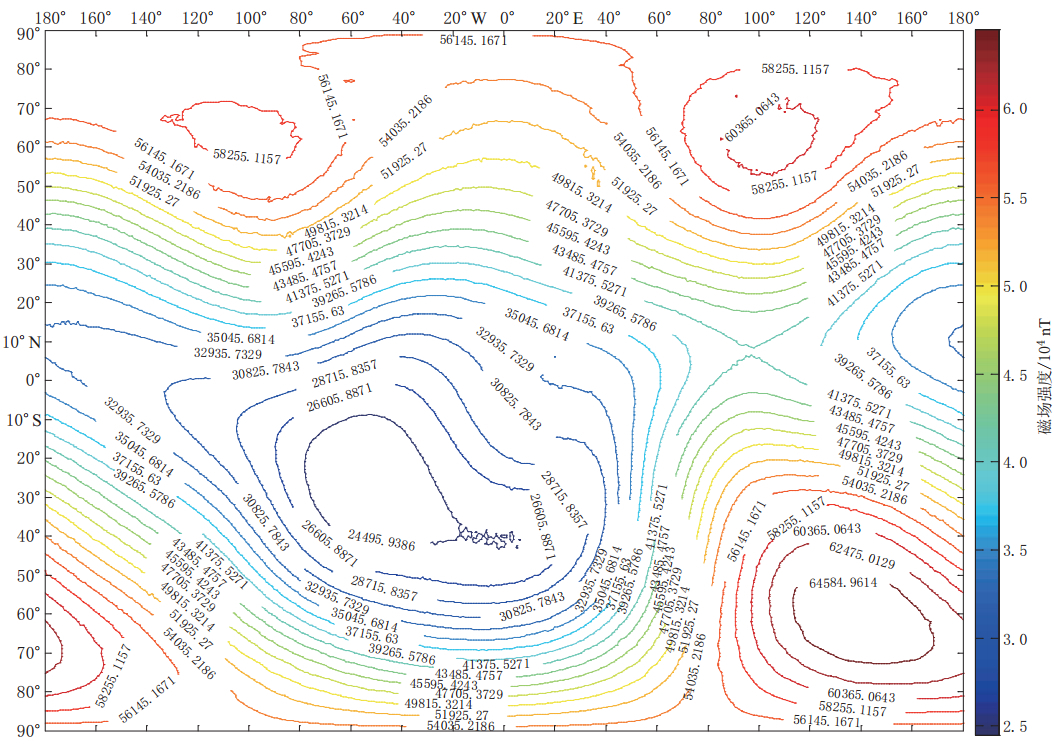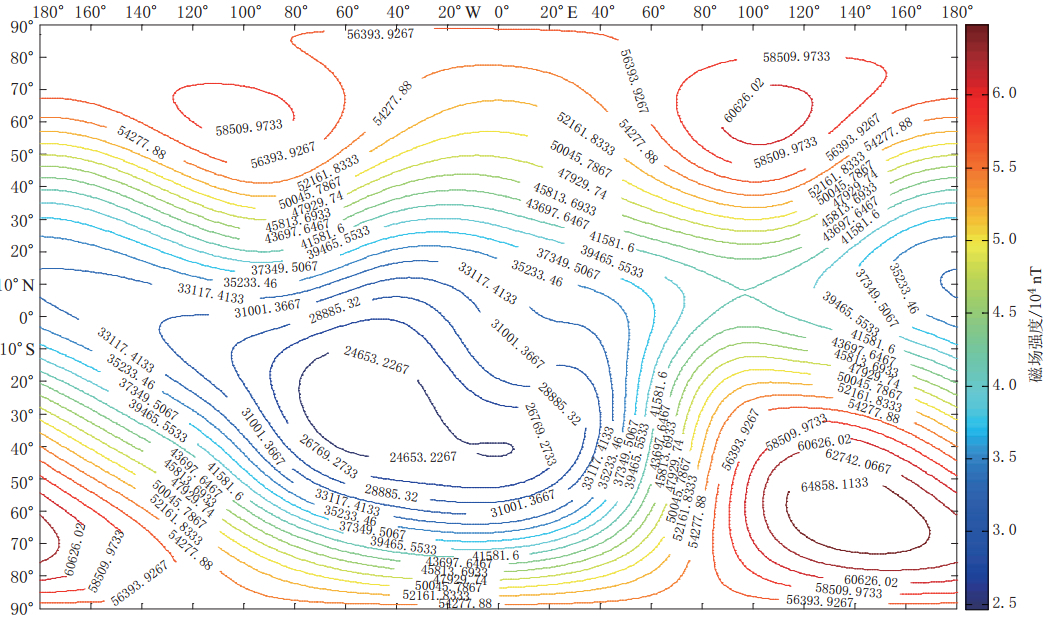Research on the eleventh generation IGRF
-
摘要: 详细阐述了国际地磁参考场模型IGRF11的建模原理、 数据来源、 球谐系数及误差来源等. 以NOAA/NGDC候选地磁场模型为例, 分析了数据的选取原则和校正方法. 在MATLAB环境下, 研制了该模型的可视化软件, 为制备地磁仿真基准图提供了最有可能和最为便捷的途径, 能有效使用国际公开数据, 减少外场地磁实测工作量和成本, 对地磁导航工程化具有重要的价值. 对模型检验值和实测值与模型计算值进行比较, 结果表明, 软件计算结果是正确的、 可靠的; 对IGRF11与WMM2010模型的异同点进行比较, 结果表明, WMM2010的模型精度要高于IGRF11, 具有更为广阔的适用范围. 最后, 从模型长期变化估算角度入手, 分析了引起IGRF11模型计算精度低的原因.Abstract: This paper expounds in detail the modeling principle, data sources, spherical harmonic coefficients and error sources of the 11th generation international geomagnetic reference field model (IGRF11). Taking the NOAA/NGDC candidate geomagnetic model as an example, an analysis is made on the data selection principle and calibration method. Under MATLAB environment, a visual software of the model was developed, providing the most possible and convenient way for making a geomagnetic reference map. This enables the effective use of international open data, and reduces the workload and cost of geomagnetic measurements, therefore, it is valuable for geomagnetic navigation. Comparing the test and measured values with the calculated value shows that the calculation results of the software are correct and reliable; and comparing IGRF11 with WMM2010 for their similarities and differences reveals that WMM2010 has higher accuracy and a wider scope of application than IGRF11. Finally, by estimating long-time variation, the reason for low calculation accuracy of IGRF11 is analyzed.
-
Keywords:
- magnetic model /
- IGRF11 /
- WMM2010 /
- spherical harmonic coefficient
-
-
表 1 数据的选择标准
Table 1 Data selection criteria

表 2 实测数据修正
Table 2 Correction of experimental data

表 3 单点位置磁场要素值
Table 3 Magnetic elements of a single spot

表 4 误差分析
Table 4 Error analysis

表 5 球谐系数的比较
Table 5 The spherical harmonic coefficients

-
安振昌. 1992. 地磁场模型和球冠谐模型分析[J]. 地球物理学进展, 7(3): 73-80. 李忠亮, 边少锋. 2011. 世界地磁场模型WMM2010及其应用[J]. 舰船电子工程, 31(2): 58-61. 王丹, 彭丰林, 马麦宁, 袁晓茹, 白春华, 孙立江. 2009. IGRF国际地磁参考场可视化研究[J]. 地震地磁观测与研究, 30(4): 7-11. 王亶文. 2005. IGRF在地磁研究中的应用[J]. 地球物理学进展, 20(2): 558-561. 王仕成, 苏德伦, 张金生. 2007. 基于WMM2005的地磁计算[C]//刘代志(主编). 第三届国家安全与军事地球物理学术研讨会. 西安: 西安地图出版社: 116-119. 徐文耀. 2000. 地磁学[M]. 北京: 地震出版社: 123-133. Ackson A, Jonkers A R T, Walker M R. 2000. Four centuries of geomagnetic secular variation from historical records[J]. Philos T Roy Soc A, 358(1768): 957-990.
Facius R, Reitz G. 2007. Space weather impacts on space radiation protection[M]//Bothmer V, Daglis L A eds. Space Weather, Physics and Effects. Berlin: Springer Verlag: 289-352.
Finlay C C, Maus S, Beggan C D. 2010. International geomagnetic reference field: the eleventh generation[J]. Geophys J Int, 183(3): 1216-1230.
Heirtzler J R. 2002. The future of the south Atlantic anomaly and implications for radiation damage in space[J]. J Atmos Sol-Terr Phy, 64(16): 1701-1708.
Kuvshinov A, Olsen N. 2004. 3-D modelling of the magnetic fields due to ocean tidal flow[M]//Reigber C, Lühr H, Schwintzer P, Wickert J eds. Earth Observation with CHAMP: Results from Three Years in Orbit. Berlin: Springer Verlag: 359-365.
Lowes F J. 2000. An estimate of the errors of IGRF/DGRF field 1945-2000[J]. Earth Planets Space, 52: 1207-1211.
Macmillan S, Turbitt C, Thomson A. 2009. Ascension and prot stanley geomagnetic observatories and monitoring the south Atlantic anomaly[J]. Ann Geophys-Italy, 52(1): 83-96.
Macmillan S, Finlay C C. 2011. The International Geomagnetic Reference Field[M]//Mandea M, Korte M eds. IAGA Special Sopron Book Series, 5: Geomagnetic Observations and Models: 265-276.
Maus S, Mclean S, Hamilton B, Thomson A, Nair M. 2010. The US/UK world magnetic model for 2010-2015[R/OL]. NOAA Technical Report NESDIS/NGDC. 1-11[2012-03-15]. http://nora.nerc.ac.uk/18737.
Newitt L R, Chulliar A, Orgeval J J. 2009. Location of the north magnetic pole in April 2007[J]. Earth Planets Space, 61: 703-710.
-
期刊类型引用(18)
1. 张秀玲,赵旭东. 基于第十三代国际地磁参考场模型在中国区域特征分析与研究. 地震学报. 2024(01): 120-128 .  本站查看
本站查看
2. 孔敏,田先德,余佳,王风帆,舒雨婷. 基于IGRF-13的海洋磁力异常重计算与精度分析. 海洋通报. 2023(01): 10-18 .  百度学术
百度学术
3. 罗凡,吕庆田,严加永,张昆,付光明,钟任富. 卫星重磁数据球坐标系下正反演方法研究进展. 地球物理学进展. 2021(04): 1420-1431 .  百度学术
百度学术
4. 戴中东,孟良,项伟,梁自忠. 机场磁偏角测量和地磁场模型计算的比较研究. 测绘通报. 2021(S1): 261-264+269 .  百度学术
百度学术
5. 王光辉,江思荣,翟光,罗宛臻. 纯磁控微小卫星姿态控制方法研究. 计算机仿真. 2018(02): 33-38 .  百度学术
百度学术
6. 张学钢,朱振才,陈宏宇,刘善伍. 利用气动力矩卸载动量轮的策略. 控制与决策. 2018(09): 1708-1712 .  百度学术
百度学术
7. 孔敏,田先德,王风帆,李维禄,张瑞端,宋晓. 国际地磁参考场模型及其应用——以南海及其周边区域为例. 海洋开发与管理. 2018(06): 82-86 .  百度学术
百度学术
8. 邓国庆,姚爱国,龚正,邱敏. 基于地面磁信标的水平定向钻进实时定位方法. 地球科学. 2017(12): 2336-2344 .  百度学术
百度学术
9. 安柏林,康国发. 基于CHAOS-5模型研究中国大陆地区地磁场长期变化. 云南大学学报(自然科学版). 2017(05): 789-797 .  百度学术
百度学术
10. 陈斌,倪喆,徐如刚,顾左文,袁洁浩,王雷. 2010.0年中国及邻近地区地磁场. 地球物理学报. 2016(04): 1446-1456 .  百度学术
百度学术
11. 董宜煊,陈金刚. 基于IGRF地磁场模型的航天器地磁干扰力矩数值仿真. 航天器环境工程. 2016(04): 387-391 .  百度学术
百度学术
12. 赵希亮,边刚,金绍华,王美娜,刘强. 世界地磁场模型WMM2015误差分析与评估. 海洋测绘. 2016(03): 10-15 .  百度学术
百度学术
13. 石在虹,滕少臣,刘子恒. 国际地磁参考场解算方法及石油工程应用. 石油钻采工艺. 2016(04): 409-414 .  百度学术
百度学术
14. 吕志峰,孙渊,张金生,王仕成,李婷. 地磁匹配导航半实物仿真方案设计及关键技术分析. 电光与控制. 2015(02): 59-64 .  百度学术
百度学术
15. 易昌华,韩华,方守川,曹国发,张瑞天. 海上地震勘探罗经鸟数据对拖缆空间位置的影响. 石油地球物理勘探. 2015(05): 809-814+801 .  百度学术
百度学术
16. 柴松均,陈曙东,张爽. 国际地磁参考场的计算与软件实现. 吉林大学学报(信息科学版). 2015(03): 280-285 .  百度学术
百度学术
17. 吕志峰,张金生,王仕成,李婷. 高精度地磁场模拟系统的设计与研究. 宇航学报. 2014(11): 1284-1290 .  百度学术
百度学术
18. 郁丰,华冰,吴云华,康国华. 基于自适应卡尔曼滤波的简化地磁定轨. 中国惯性技术学报. 2014(04): 519-524 .  百度学术
百度学术
其他类型引用(18)





 下载:
下载:

